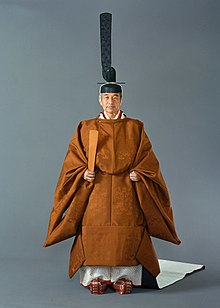Sokutai
This article needs additional citations for verification. (February 2014) |


The sokutai (束帯) is a traditional Japanese outfit worn only by courtiers, aristocrats and the emperor at the Japanese imperial court. The sokutai originated in the Heian period, and consists of a number of parts, including the ho (outer robe), shaku (笏), a flat ritual baton or sceptre, and the kanmuri (冠), a cap-shaped black lacquered silk hat with an upright pennon decorated with the imperial chrysanthemum crest.[1]
The exact composition of the sokutai differs from person to person, and depends on a person's rank and whether they are a civil or military official, with military officers wearing the garment's outermost layers with split front and back panels, and civil officials having fully sewn panels. Colour also varies by rank, with colour symbolism having held great importance in Heian period Japan.
No longer worn as everyday clothing, the sokutai is preserved as formalwear worn by male members of the Imperial court, including the Imperial family and government officials, such as the Prime Minister. The sokutai is typically reserved for the most formal occasions, such as weddings and enthronement ceremonies. On such occasions, women such as an empress or princess wear a jūnihitoe, the sokutai's female counterpart.
Colour symbolism[]
Similarly to the jūnihitoe, the sokutai uses colour symbolism, though unlike the jūnihitoe, colours are more restricted, specifically denoting rank:
- First rank: purple
- Second rank: purple
- Third rank: purple
- Fourth rank: maroon
- Fifth rank: crimson
- Sixth rank: dark green
- Seventh rank: light green
- Eighth rank: dark blue
- Basic rank (ranks below eighth): light blue
Persons without rank typically wear mud brown or light yellow; the darker, fuller shade of yellow was reserved for the emperor. Though exact shades varied highly, with a number of colours detailed as having miniscule shade differences and thus different names, the highest-ranking shades were all achieved through dyeing fabric with the gromwell plant, an expensive and prolonged process that could take over a year to achieve.[2] Due to the difficulty of obtaining a number of dyestuffs used to produce the purple and maroon colours worn by the highest-ranked officials, these colours were changed to black sometime during the Heian period.
Composition[]
The sokutai's innermost layer was the kosode (小袖, lit., "short sleeve"), a white garment that covered the wearer to knee level. This was worn with a pair of Ōkuchi-hakama, a pair of long red hakama worn on top of the kosode and tied off to the wearer's left. Similarly to the jūnihitoe, which used a white kosode and a pair of red hakama as a base layer, both of these would have been worn as both undergarments and sleeping clothes.
A hitoe ("lit., "unlined garment") was worn over the top of the kosode as an upper garment; a number of layers of akome were worn above the hitoe, the exact number and fabric of which varied based on the season. The ue-no-bakama, a shorter white hakama with an open fly, was worn above the akome, tied off to the right. The shitagasane, a typically white garment with the characteristic "tail" of the sokutai, was worn on top of the akome, covering the upper body of the wearer. The hampi - a sleeveless vest often featuring embroidery - was worn over all these layers. The final outer robe - the ho - was then worn over the hampi; this outer robe followed the design of the Chinese yuanlingpao in its cut, but with a distinctively Japanese style, with the robe tucked at the waist, such that the skirts ends midway between the knees and floor.[1]
References[]
- ^ Jump up to: a b "Dress - Japan". Encyclopedia Britannica. Retrieved 24 March 2021.
- ^ Parmal, Pamela A. (2004). "The Impact of Synthetic Dyes on the Luxury Textiles of Meiji Japan" (pdf) (Symposium Proceedings (474)). Textile Society of America. Archived from the original on 21 July 2020. Retrieved 2 September 2021.
The roots [of the plant] are collected and dried for two to three months to mature the color. While this occurs, the silk is pre-mordanted...the mordanting process involves repeated immersion of the cloth or yarn in the alum bath and drying over a two- ir three-month period. To prepare the dyestuff, the gromwell roots are softened overnight in 60°[celsius] water and then pounded to release the dye. The silk is then repeatedly immersed in the bath, aired to allow more oxygen to penetrate the cloth and then steeped in the dye until the desired color is achieved. When the dyeing is completed the cloth is placed in dark storage for as long as a year while the color continues to mature.
External links[]
| Wikimedia Commons has media related to Sokutai. |
- Japanese clothing
- Robes and cloaks
- Court uniforms and dress
- Japanese words and phrases
- Japan culture stubs
- Fashion stubs
